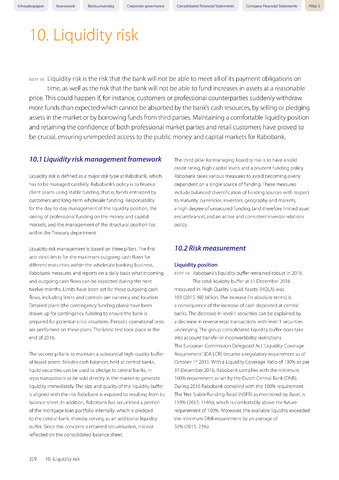10. Liquidity risk
EDTF18 Liquidity risk is the risk that the bank will not be able to meet all of its payment obligations on
time, as well as the risk that the bank will not be able to fund increases in assets at a reasonable
price.This could happen if, for instance, customers or professional counterparties suddenly withdraw
more funds than expected which cannot be absorbed by the bank's cash resources, by selling or pledging
assets in the market or by borrowing funds from third parties. Maintaining a comfortable liquidity position
and retaining the confidence of both professional market parties and retail customers have proved to
be crucial, ensuring unimpeded access to the public money and capital markets for Rabobank.
7 0.7 Liquidity risk management framework
70.2 Risk measurement
Inhoudsopgave Voorwoord Bestuursverslag Corporate governance Consolidated Financial Statements Company Financial Statements Pillar 3
Liquidity risk is defined as a major risk type at Rabobank, which
has to be managed carefully. Rabobank's policy is to finance
client assets using stable funding, that is, funds entrusted by
customers and long-term wholesale funding. Responsibility
for the day-to-day management of the liquidity position, the
raising of professional funding on the money and capital
markets, and the management of the structural position lies
within theTreasury department.
Liquidity risk management is based on three pillars.The first
sets strict limits for the maximum outgoing cash flows for
different maturities within the wholesale banking business.
Rabobank measures and reports on a daily basis what incoming
and outgoing cash flows can be expected during the next
twelve months. Limits have been set for these outgoing cash
flows, including limits and controls per currency and location.
Detailed plans (the contingency funding plans) have been
drawn up for contingency funding to ensure the bank is
prepared for potential crisis situations. Periodic operational tests
are performed on these plans. The latest test took place at the
end of 2016.
The second pillar is to maintain a substantial high-quality buffer
of liquid assets. Besides cash balances held at central banks,
liquid securities can be used to pledge to central banks, in
repo transactions or be sold directly in the market to generate
liquidity immediately. The size and quality of the liquidity buffer
is aligned with the risk Rabobank is exposed to resulting from its
balance sheet. In addition, Rabobank has securitised a portion
of the mortgage loan portfolio internally, which is pledged
to the central bank, thereby serving as an additional liquidity
buffer. Since this concerns a retained securitisation, it is not
reflected on the consolidated balance sheet.
The third pillar for managing liquidity risk is to have a solid
credit rating, high capital levels and a prudent funding policy.
Rabobank takes various measures to avoid becoming overly
dependent on a single source of funding. These measures
include balanced diversification of funding sources with respect
to maturity, currencies, investors, geography and markets,
a high degree of unsecured funding (and therefore limited asset
encumbrance) and an active and consistent investor relations
policy.
Liquidity position
edtf 18 Rabobank's liquidity buffer remained robust in 2016.
The total liquidity buffer at 31 December 2016
measured in 'High Quality Liquid Assets' (HQLA) was
103 (2015: 98) billion.The increase (in absolute terms) is
a consequence of the increase of cash deposited at central
banks.The decrease in level 1 securities can be explained by
a decrease in reverse repo transactions with level 1 securities
underlying. The group consolidated liquidity buffer does take
into account transfer or inconvertibility restrictions.
The European Commission Delegated Act 'Liquidity Coverage
Requirement' (DA LCR) became a regulatory requirement as of
October 1st 2015. With a Liquidity Coverage Ratio of 130% as per
31 December 2016, Rabobank complies with the minimum
100% requirement as set by the Dutch Central Bank (DNB).
During 2016 Rabobank complied with the 100% requirement.
The 'Net Stable Funding Ratio' (NSFR) as monitored by Basel, is
119% (2015:116%), which is comfortably above the future
requirement of 100%. Moreover, the available liquidity exceeded
the minimum DNB requirement by an average of
32% (2015: 23%).
359 10. Liquidity risk

